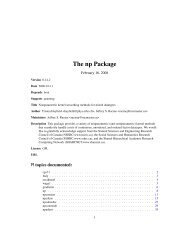The gstat Package - NexTag Supports Open Source Initiatives
The gstat Package - NexTag Supports Open Source Initiatives
The gstat Package - NexTag Supports Open Source Initiatives
Create successful ePaper yourself
Turn your PDF publications into a flip-book with our unique Google optimized e-Paper software.
krige.cv 21formulalocationsdatamodelbetanmaxnminmaxdistformula that defines the dependent variable as a linear model of independentvariables; suppose the dependent variable has name z, for ordinary and simplekriging use the formula z~1; for simple kriging also define beta (see below);for universal kriging, suppose z is linearly dependent on x and y, use the formulaz~x+yformula with only independent variables that define the spatial data locations(coordinates), e.g. ~x+y, OR data object deriving from class Spatial, whichhas a coordinates method to extract its coordinates.data frame; should contain the dependent variable, independent variables, andcoordinates; only to be provided if locations is a formulavariogram model of dependent variable (or its residuals), defined by a call tovgm or fit.variogramonly for simple kriging (and simulation based on simple kriging); vector with thetrend coefficients (including intercept); if no independent variables are definedthe model only contains an intercept and this should be the simple kriging meanfor local kriging: the number of nearest observations that should be used for akriging prediction or simulation, where nearest is defined in terms of the spaceof the spatial locations. By default, all observations are usedfor local kriging: if the number of nearest observations within distance maxdistis less than nmin, a missing value will be generated; see maxdistfor local kriging: only observations within a distance of maxdist from the predictionlocation are used for prediction or simulation; if combined with nmax,both criteria applyDetailsValueLeave-one-out cross validation (LOOCV) visits a data point, and predicts the value at that locationby leaving out the observed value, and proceeds with the next data point. (<strong>The</strong> observed value isleft out because kriging would otherwise predict the value itself.) N-fold cross validation makes apartitions the data set in N parts. For all observation in a part, predictions are made based on theremaining N-1 parts; this is repeated for each of the N parts. N-fold cross validation may be fasterthan LOOCV.data frame containing the coordinates of data or those of the first variable in object, andcolumns of prediction and prediction variance of cross validated data points, observed values, residuals,zscore (residual divided by kriging standard error), and fold.If all.residuals is true, a data frame with residuals for all variables is returned, without coordinates.Methodsformula = "formula", locations = "formula" locations specifies which coordinates in data referto spatial coordinatesformula = "formula", locations = "Spatial" Object locations knows about its own spatial locations
















